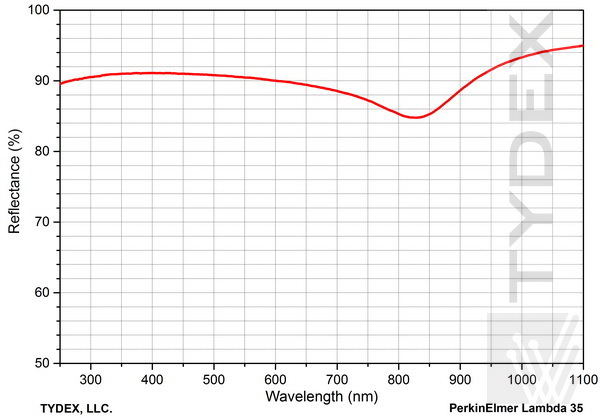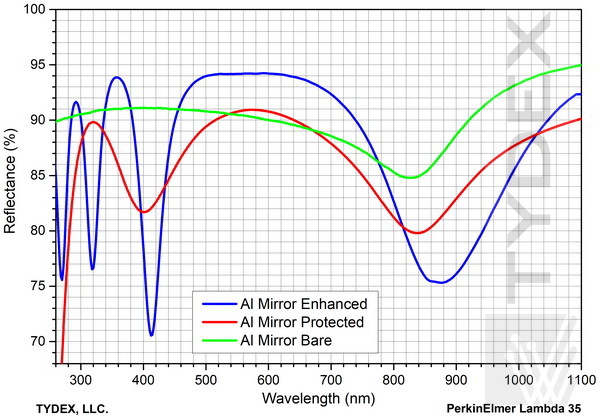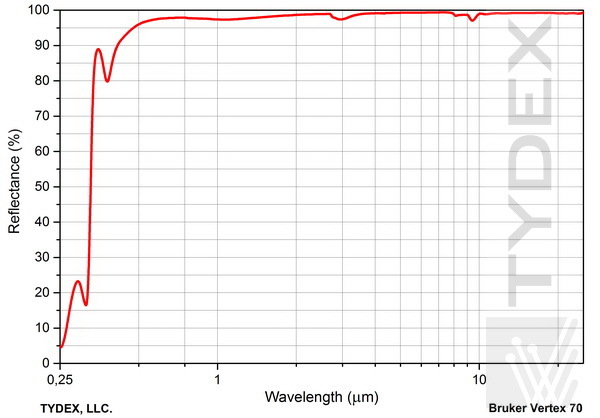Metal Mirrors
| Download Optical Coatings Datasheet (PDF, 7 MB) |
Metal mirrors are used when high reflection in a wide spectral range is necessary. The reflectance of metal mirrors, unlike dielectric ones, does not depend very much on polarization the angle of incidence of light. The main disadvantages of metallic mirrors, in comparison with dielectric ones, are a slightly smaller reflection coefficient at given wavelengths and a significantly smaller radiation resistance.
1. Aluminum Mirrors
2. Silver Mirrors
3. Gold Mirrors
1. Aluminum Mirrors
Aluminum mirrors remain the most commonly used metal mirrors due to its good reflection from UV to far IR and THz range, low cost and high resistance to external influences. Contacting with air, aluminum forms a layer of Al2O3 oxide a few nanometers thick. The layer is optically transparent, very dense and chemically stable. This layer provides the highest chemical resistance of aluminum film, but can not protect it from mechanical influences. If no such effects are expected on the mirror, an aluminum layer without protection can be used. Such mirrors are extremely useful, for example, inside scientific instruments, when the protective layer can be a source of undesirable interference or absorption.

Fig. 1. Reflection of an unprotected aluminum film
But often additional protection of the reflective layer is required.
1.1. Protected Aluminum
1.1.1. Aluminum mirrors with SiO2 and SiO protective coating are among the most commonly used. This coating is mechanically strong enough for most applications, but reduces a bit the reflection in the UV. In addition, it has some absorption by 3 μm (water) and by 9-11 μm (Si-O bond).
| Wavelength, μm | Average reflectance, % | Damage threshold, J/cm2, 50 ns pulse |
| 0.25-20.0 | >90 | 0.25-0.3 |

Fig. 1.1. Reflection spectrum of an aluminum film with SiO2 protective coating.
1.1.2. As SiO2, and even more SiO, demonstrates high absorption at wavelengths shorter than 250 nm, such mirrors are bad in deep UV. For mirrors operating in the 200-250 nm range, it is preferable to use the MgF2 layer as a protection. It reduces the absorption loss in protection, but its mechanical strength is lower. Another important factor of losses in the GUF is scattering; for reducing it aluminum should be sprayed in a special way.
1.2. Enhanced Aluminum
Instead of a single-layer protection, it is possible to make a multilayer structure on the top of the aluminum film, which will slightly increase the reflection in the visible or near-IR range. Outside the "amplification" range, the reflection will be lower than that of bare aluminum. The damage threshold also remains at the level of unprotected aluminum.
| Wavelength, μm | Average reflectance, % | Damage threshold, J/cm2, 50 ns pulse |
| 0.4-0.7 | >93 | 0.25-0.3 |

Fig. 1.2.А. Reflection of “enhanced” aluminum
Fig. 1.2.В. Comparison of reflection of enhanced, standard and unprotected aluminum films
1.3. Metal-dielectric Mirrors
By increasing the number of dielectric layers on top of the aluminum film, reflection above 99% in the required spectral region can be achieved. A high-grade dielectric mirror is created on top of the aluminum film. The advantage of this design in comparison with the standard dielectric mirror is a high reflection in the entire spectral range and a lower sensitivity of the structure to a change in the angle of incidence and polarization of light. But the damage threshold of these structures remains low, for this reason they are not to be used in power optics.

Fig. 1.3. Reflection of a metal-dielectric mirror.
Silver mirrors differ from aluminum ones by a higher reflection in the visible and infrared ranges, but noticeably worse reflection in UV. Unlike Al2O3 , silver oxide does not form a strong and stable film on the surface of silver and can not provide either mechanical or chemical protection of the metal. That is why the use of silver mirrors without a protective layer is almost impossible even when the mirror is protected from mechanical influences.
| Wavelength, μm | Average reflectance, % | Damage threshold, J/cm2, 50 ns pulse |
| 0.4-0.7 | >95 | 0.25-0.3 |
| 3-15 | >98 |
2.1. Silver with Protection
Protecting the silver layer with a dielectric film makes the structure mechanically and chemically resistant.

Fig. 2.1. Reflection of a silver film with a protective coating.
2.2. “Sealed” Silver
Even the smallest pores in the protective film allow the silver to chemically interact with air, acid gases and water. The lifetime of silver mirrors can be significantly reduced by the heavy loads from the environment, such as high temperature and humidity, high industrial air pollution. The application of an additional protective layer in a special additional process allows to "seal" the pores in the protective film (also on the edges of the mirror) and significantly prolong the service life of the product. This can be especially important for equipment located in hard-to-reach places. Optically, this coating is virtually indistinguishable from standard p-silver.
Gold mirrors are most often used in the infrared range. For light with wavelengths shorter than 600 nm, the reflection from gold is very low. Gold is chemically neutral, so even without a protective layer; it practically does not interact with atmospheric gases and water. This allows gold to be used without protection in scientific instruments, when interference or absorption lines in protective layers can be undesirable. But it should be remembered that the gold layer is extremely soft and can easily be damaged mechanically. For most applications, gold should be covered with an oxide protective structure.
| Wavelength, μm | Average reflectance, % | Damage threshold, J/cm2, 50 ns pulse |
| 0.6-20 | >98 | 0.25-0.3 |
3.1. Unprotected Gold

Fig. 3.1. Reflection of bare gold
3.2. Protected Gold

Fig. 3.2. Reflection of p-gold
3.3. Gold Mirrors for Carbon Dioxide Lasers
The usual protective layer on the gold mirror has some absorption at 10.6 μm, which reduces the radiation resistance of the product. The special design of the protection allows to reduce the absorption and thereby slightly increase the damage threshold and the reflection coefficient. But it is necessary to keep in mind when working with a CO2 laser in a (quasi) continuous mode, the damage threshold will be determined primarily by the thermal conductivity of the substrate and by other factors.

Fig. 3.3. Reflection of gold mirrors for carbon dioxide lasers
3.4. THz Mirrors
The penetrating power of electromagnetic radiation in a conductor is proportional to the wavelength. Therefore, to ensure high reflection in the THz range, a thicker metal film is required than for working in the visible and near-mid-IR range. Studies confirm that some "standard" metal mirrors show a drop in reflection in the terahertz range. To ensure high reflection, we apply a sufficiently thick layer of metal. For more information about the product, see the article THz mirrors.
The following spectrum helps to compare the optical properties of metal mirrors, discussed above.

Optics is ready to be shipped!
Optics Stock
Shipment/ Payment/ Warranty ...






